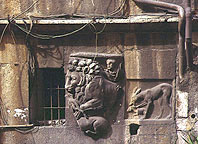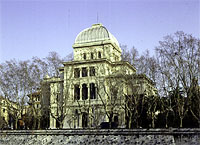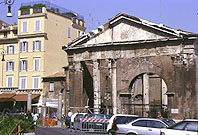From the Tiber Island to the Ghetto
Ghetto
 When created in the 16C, the Ghetto was a tiny area bounded by Via del Progresso, Via del Portico d'Ottavia, and Lungotevere Cenci. (See picture: Facade of Casa di Lorenzo Manilio)
When created in the 16C, the Ghetto was a tiny area bounded by Via del Progresso, Via del Portico d'Ottavia, and Lungotevere Cenci. (See picture: Facade of Casa di Lorenzo Manilio)
![]() Counter Reformation. Part of the reason for the ghetto-ization of Rome's Jews stemmed from Martin Luther's disgust at both the Church's opulence: the life style of the Cardinals and its sale of Indulgences, which forgave sins. In 1517 he nailed his famous 95 "Theses" on the Wittenberg church door.
Counter Reformation. Part of the reason for the ghetto-ization of Rome's Jews stemmed from Martin Luther's disgust at both the Church's opulence: the life style of the Cardinals and its sale of Indulgences, which forgave sins. In 1517 he nailed his famous 95 "Theses" on the Wittenberg church door.
The Protestant -in protest -movement was born! The Catholic Church responded with the Counter Reformation; invented the Inquisition, and oppressed the Jews in Rome because Church dogma blamed them for killing Christ.
| Ghetto History In Ancient times, Rome's Jews were just another ethnic minority attracted to the big city. All non-Romans were obliged to reside in Trastevere, but could circulate freely doing their business during the day. 220 BC. The Circus Flaminius (in part of the present Ghetto) was inaugurated to amuse the populace with racing and other sports. Being near the river, it was often flooded for games, as in 2 BC when 36 crocodiles were butchered here. 162 BC. A delegation of Macabees (Jews) came to Rome asking for help to repel the Syrians. 0. In Christ's time Israel was a handful of Hebrew Roman provinces (Canaan, Philistia, Judah, Israel, etc.). 50 AD. In Nero's court the most famous actor was Jewish, and Empress Poppea showered the actor's co-religionists with her intimate favors. 66 AD. Following the great Jewish rebellion against Rome, Judea was conquered. 70 AD. While Vespasian was Emperor, his son Titus attacked Jerusalem, destroyed the Temple of Solomon and slaughtered or enslaved many of the Jews. A large number of the survivors fled, starting the Diaspora. He carried back to Rome the famous golden 7-branched candelabra (see Arch of Titus). Judaism was recognized as a legitimate religion by Rome. 13C. Many Jews move across the river from Trastevere to this area. 1555-59. Pope Paul IV Carafa forbade Jews living outside the Ghetto and built a wall to enclose them. The gates opened at dawn and closed at dusk. There were humiliating and stringent limits to what trades they could practice (sale of old furniture and used clothing) and even how many rings they could wear. The area was absurdly small for so many people. After Pope Paul IV's death the rules were eased, but Jews still had to run on foot in the annual horse-races down Via del Corso. 1808. During French invasion of Rome Napoleon rescinds the Ghetto laws, which were thereafter reinstated. 1848. The Ghetto was abolished, temporarily. 1888. Its walls were demolished. 1904. The Synagogue built. 1938. Mussolini, who had been tolerant of Jews, passed racial laws against them (though many had participated in his march on Rome in 1922). 1943. 2091 Romans (about 1,000 Jews) were sent to concentration camps, only 16 returned. 1944. 335 civilians, including 100 Jews, were executed by the German occupiers at the Fosse Ardeatine. 1948. After refusing to pass under the Arch of Titus for some 1870 years, a joyous Roman Jewish crowd charged through to celebrate the creation of the State of Israel. 1986. Pope John Paul II Woytila removed from the Church's ritual the blame on the Jews for having killed Christ. His visit to the Rome Synagogue was the first time ever for a Pontiff. Today the Ghetto is a picturesque quarter of Rome where Jew and Gentile live happily together as in ancient times. Italy's Jewish population is the same today as it was in the city of Rome under Emperor Nero. |
Synagogue
 (Sinagoga). This aluminum-domed temple is a choice example of Assyrian-Babylonian style, built after the Ghetto walls were destroyed (1904, Armanni and Costa). In addition to being a place of worship, it houses the Permanent Exhibition of Rome's Jewish Community.
(Sinagoga). This aluminum-domed temple is a choice example of Assyrian-Babylonian style, built after the Ghetto walls were destroyed (1904, Armanni and Costa). In addition to being a place of worship, it houses the Permanent Exhibition of Rome's Jewish Community.
A major development in inter-religious relations was Pope John Paul II's attendance at a special service in April 1986.
Portico d’Ottavia
 Emperor Augustus built (27 BC) this covered colonnaded walkway, vestiges of which can be seen in the monumental entry of the Church of St. Angelo in Pescheria. He named it after his sister Octavia, married to Mark Anthony (of Cleopatra fame). He joined the Theater of Marcellus to the Theater of Pompey (about half a mile/three quarters of a kilometer away).
Emperor Augustus built (27 BC) this covered colonnaded walkway, vestiges of which can be seen in the monumental entry of the Church of St. Angelo in Pescheria. He named it after his sister Octavia, married to Mark Anthony (of Cleopatra fame). He joined the Theater of Marcellus to the Theater of Pompey (about half a mile/three quarters of a kilometer away).
There used to be statues running atop this gloriously elegant walkway, under which one never got wet or had sunstroke. Octavia later added a rectangular colonnade, the Circus Flaminius, and two temples.
There can be confusion between two other ancient walkways: one, Porticus Octavia, built in 168 BC by Octavius; the other, Porticus Metelli, built in 147 BC by Q. Cecilius Metellus Macedonicus - both lost forever.
Recent excavations have gone down a meter and discovered beautiful large marble slabs of the original pavement. The dilemma: whether to continue the excavations and how far? The only section that survived became a fish market in Medieval times. There are fish measurements inscribed in Latin on the right arch. It is also written that fish over a certain size were to be given to the city authorities.
St. Gregorio della Divina Pietà
(St. Gregory of Heavenly Mercy). This tiny church is across from the Synagogue, at the entrance to the Ghetto.
Over the door the inscription from Isaiah in the Old Testament says it all: "I spread out my hands all the day unto a rebellious people which walketh in a way that was not good after their own thoughts".
This finger-slapping rebuke to the Jews inscribed in Latin and Hebrew, seems out of step with our times, when both Pope John XXIII and Pope John Paul II have made gestures to end the enmity between the Catholic Church and the Jews.
While Rome's Jews were forced to live in the Ghetto they were herded into this church every Sunday in an attempt to convert them to Christianity. The cozy interior has a single nave with charming frescoes on ceiling and walls, and a Baroque sun-and-cloud burst behind the altar framing a Virgin and Child.